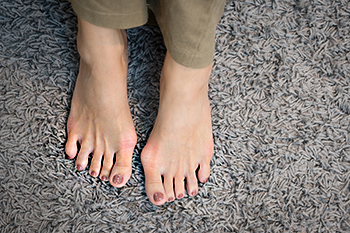
There is no mistaking a bunion. It is easily noticed by the hard bump that forms on the side of the big toe. It is considered to be a deformity and can happen from wearing shoes that do not have adequate room in the toe area. It may also occur for genetic reasons or as a result of an abnormal foot structure. If the bunion is severe, it may force the other toes to shift away from the big toe and toward each other, possibly causing the need for wider shoes to be purchased. Corns and calluses may form on top of the toes where they meet the shoe, and there may be a reduced range of motion in the big toe. Mild relief may be found when a protective pad is worn over the bunion and larger shoes are worn. Some patients will have their podiatrist tape their foot into a normal position, and this may be helpful in eliminating any existing pressure. Surgery may be considered for permanent removal, and this type of treatment may be chosen if the bunion interferes with completing daily activities. If you have developed a bunion, it is suggested that you consult with a podiatrist who can help you with the treatment option that is best for you.
If you are suffering from bunions, contact Pedram Aslmand, DPM of Advanced Foot and Ankle Center. Our podiatrist can provide the care you need to keep you pain-free and on your feet.
What Is a Bunion?
A bunion is formed of swollen tissue or an enlargement of boney growth, usually located at the base joint of the toe that connects to the foot. The swelling occurs due to the bones in the big toe shifting inward, which impacts the other toes of the foot. This causes the area around the base of the big toe to become inflamed and painful.
Why Do Bunions Form?
Genetics – Susceptibility to bunions are often hereditary
Stress on the feet – Poorly fitted and uncomfortable footwear that places stress on feet, such as heels, can worsen existing bunions
How Are Bunions Diagnosed?
Doctors often perform two tests – blood tests and x-rays – when trying to diagnose bunions, especially in the early stages of development. Blood tests help determine if the foot pain is being caused by something else, such as arthritis, while x-rays provide a clear picture of your bone structure to your doctor.
How Are Bunions Treated?
- Refrain from wearing heels or similar shoes that cause discomfort
- Select wider shoes that can provide more comfort and reduce pain
- Anti-inflammatory and pain management drugs
- Orthotics or foot inserts
- Surgery
If you have any questions, please feel free to contact our offices located in Long Beach, CA . We offer the newest diagnostic and treatment technologies for all your foot care needs.

